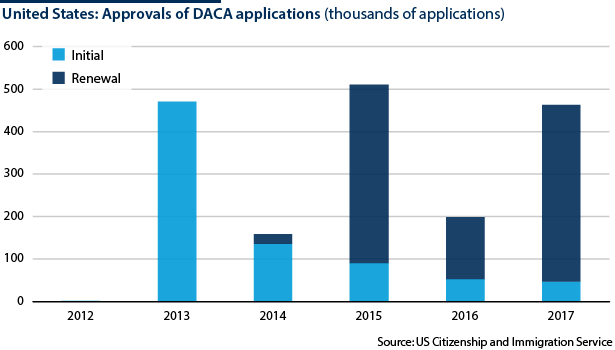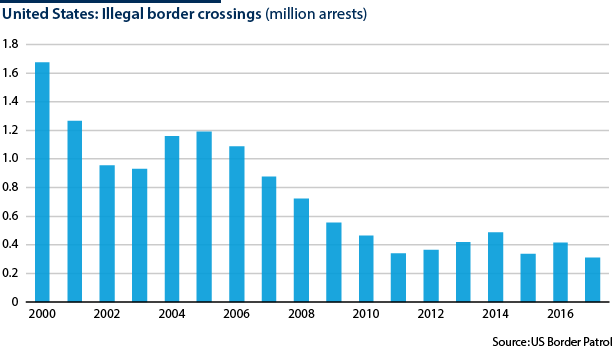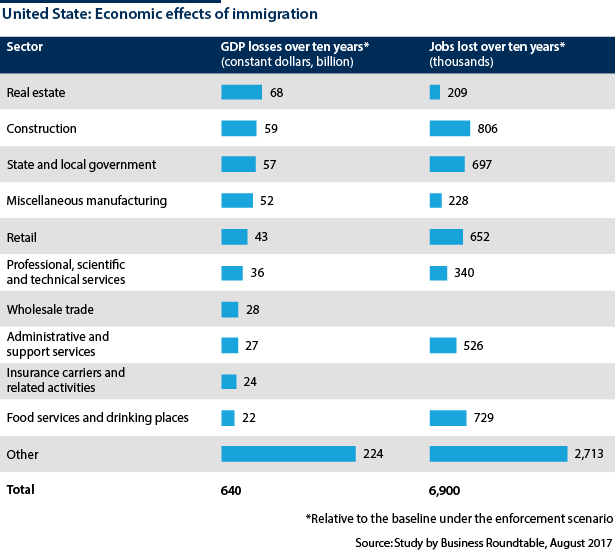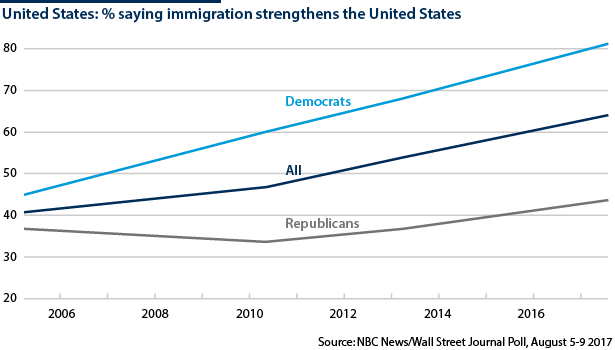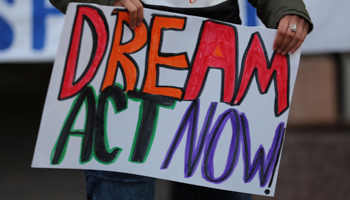Restricting immigration will lower US GDP
A crackdown on both legal and illegal immigration will crimp consumption, productivity and labour market growth
Tensions over immigration are bubbling to the surface as the future of the Deferred Action for Childhood Arrivals (DACA) policy is entangled with efforts to pass a spending bill and keep the US federal government open beyond January 19. Against a backdrop of polarising political debate, concerns about the economic impact of lower net immigration risk being overlooked.
What next
This year is likely to witness ugly wrangling over immigration policy, driven by partisan and internal party cleavages. This will bleed into the 2018 midterm campaigns. Meanwhile, President Donald Trump's administration is determined to deliver on its nativist, "America-First" agenda and is expected to pursue more immigration crackdowns and restrictions, damaging GDP growth prospects as a result of muted consumer spending and possible labour shortages putting upward pressure on wages.
Subsidiary Impacts
- Arrests of illegal immigrants rose sharply to September 2017 and deportations could surge this year; workplace raids will also increase.
- Having fallen to the lowest in 45 years, illegal border crossings are likely to continue to fall as detection processes are improving.
- With the US unemployment rate at near its lowest this century, some sectors could struggle to find workers.
- GDP could be cut by one-tenth of a percentage point in each year of Trump's first term as a result of lower immigration, Moody's estimates.
Analysis
Established by the Obama administration in June 2012, DACA allowed individuals who entered the United States illegally as minors to stay in the country for a renewable two-year period and qualify for a work permit. Supporters of the programme cite its fairness -- it shields from deportation people who in most cases have lived in the United States for most of their lives and for whom the decision to come illegally rested with their parents.
The Trump administration rescinded DACA in September 2017 as part of an effort to fulfil anti-immigration campaign promises and please critics of the programme, who claim that it amounts to amnesty for those who violated the law (see UNITED STATES: Congress will cover for Trump on DACA - September 13, 2017). Upon cancelling the policy, Trump announced that Congress needed to decide by March 5 the future of the 690,000 people protected under DACA.
With this deadline looming -- as well as another deadline to pass a spending bill arriving on January 19 -- congressional Democrats are seeking to force Republicans to agree on a revival of DACA in exchange for their votes to keep the government funded.
DACA and spending bill clash
The debates rocking Washington do not affect just pro-DACA Democrats and their opponents. Several issues will make it difficult to force a compromise on a spending bill and ultimately to agree on immigration policy.
Republican defence hawks want the spending bill to include new defence spending provisions while Democrats will only agree to these if the bill includes matching increases in domestic spending on social programmes.
Republicans want a spending bill to include defence provisions, the Democrats want more social spending
Immigration policy
Republicans are unified in arguing that the DACA debate should be divorced from the spending package issue and wrapped instead into questions about broader US immigration policy. These questions are even more extensive, including:
The wall
Trump needs to deliver on his signature campaign issue: the US-Mexico wall (see MEXICO-US: Wall will divide, whether built or not - September 6, 2016). Most members of Congress -- across the political spectrum -- recognise the futility and frivolity of the proposal, but believe that the administration is unlikely to back down.
Immigration restrictions
Other immigration hardliners in the Republican party want to overhaul the broader system to:
- crack down hard on illegal immigration;
- reduce significantly the number of green cards (permanent residence permits) granted each year, continuing the 2017 trend after the numbers awarded green cards fell by 3.1% quarter-on-quarter in April-June and by 11.0% in July-September;
- end so-called 'chain migration', a practice whereby immigrants who gain legal status can use family-friendly provisions to bring in relatives; and
- end the immigration diversity lottery system, which annually makes about 55,000 visas available for people from traditionally underrepresented nationalities.
Democratic/Republican ideologies
Democrats, in addition to preserving DACA, want to block as many new immigration restrictions proposed by the hardliners as possible.
Traditional, pro-business Republicans want to prevent the debate from escalating before the 2018 midterm elections, while also preserving certain employment-based visa programmes that help US businesses fill skill shortages, including the H1-B programme for high-skilled workers.
Longer term developments
The DACA and spending bill debates and public consternation over Trump's offensive comments about immigrants are occurring while several critical, longer-term developments brew on US immigration policy.
Since taking office, the Trump administration has pursued an extensive, multi-pronged strategy to restrict the number of legal and illegal immigrants coming and residing in the United States.
Incremental measures
Trump has failed to deliver on his iconic promise of a wall yet, but his administration -- primarily through the initiative of his senior advisor Stephen Miller -- has launched a broad-based assault on both illegal and legal immigration by upping the enforcement of existing law and implementing new executive orders.
Evidence suggests that even the administration's tone and rhetoric have managed to discourage new immigrant arrivals.
45,000
Trump has lowered the cap on refugee admissions to the lowest since 1980
Aside from ending DACA, these measures are being pursued outside the public eye, avoiding serious public scrutiny. For example:
- The Trump administration has lowered the overall cap on refugee admissions from 110,000 to 45,000, the lowest since 1980, and is implementing an 'extreme vetting' policy to take admissions far lower. In October, refugee admissions were 88% fewer than a year earlier.
- Executive Order 13769 (the Muslim travel ban) continues to face legal wrangling, but the early months of Trump's administration saw a substantial drop in the share of refugees identifying as Muslim, from 50% in February to 31% in June. The share edged up again towards the end of 2017, but the fiscal year to end-September 2017 marked a shift from a Muslim plurality to a Christian plurality. The trend of a higher percentage of refugees identifying as Christian and a lower percentage as Muslim is likely to continue in 2018.
- In November, the administration declined to renew the Temporary Protected Status (TPS) of 2,500 Nicaraguans. Moreover, the Department of Homeland Security (DHS) announced that TPS, which currently covers ten countries, will end by July 2019 for Haitians and Nicaraguans -- all 60,000 Haitian refugees residing in the United States after the 2010 earthquake must either leave or obtain another form of legal status (see LATIN AMERICA/US: Migrant returns threaten stability - January 5, 2018).
- The administration is working to expand the number of immigration courts and detention centres, and seeks to double the staff of the Immigration and Customs Enforcement (ICE) by 2023.
- Although the number of deportations in the year to September 2017 was flat compared to the prior year, arrests of illegal immigrants by ICE rose by 40% -- indicating that deportations may surge this year.
- ICE is calling for an increase in workplace raids. On January 10, the authorities raided almost 100 '7-11' convenience stores across 18 states, arresting 21 employees and serving notice that employment records will be audited.
- The DHS reports that it now catches an estimated 55-85% of illegal border crossings, up from 35-70% a year ago.
- Illegal border crossings have plunged to their lowest level in 45 years due to these tactics. Applications for H1-B visas and the number of foreign students enrolling at US universities have also dropped, likely due to worries that obtaining or retaining an employment visa will become more difficult.
Economic damage...
Pew Research estimated in 2017 that there were 11 million unauthorised immigrants living in the United States (2015 data), representing 3-4% of the population and 5% of the workforce, many in low-wage employment such as farm work and maintenance.
Two City University of New York economists, Ryan Edwards and Francesc Ortega, estimated that undocumented workers contribute 3% of goods and services produced by the private sector, and that a policy of mass deportation would reduce GDP by 4.7 trillion dollars over ten years and federal government revenue by nearly 900 billion dollars
In August 2017, the Business Roundtable modelled the economic effects of immigration, focusing on deportation and enforcement measures that it estimated would lead to the removal of three-quarters of the undocumented immigrant population and would cause a 75% decline in the future flow of unauthorised immigration -- resulting in 11.8 million fewer immigrants in ten years compared to the status quo baseline.
$640bn
GDP loss over ten years if policy reduces immigrant numbers by 11.8 million
Its model implied a loss of around 3% from US GDP growth over the next ten years relative to the baseline scenario, a 640-billion-dollar loss of economic output.
First, fewer people living in the United States mean billions of dollars less in consumer spending, including on restaurant meals, entertainment, furniture, housing and mobile phones. Higher inflation, especially food prices as result of possible supply chain dislocation, could also exacerbate this.
Second, a sharp reduction in the number of illegal immigrants would lead to disruptions and labour shortages in many industries, especially construction and agriculture.
...may be underestimated
Under the Trump administration, the substantial decline in future unauthorised immigration modelled in the study will likely play out; similarly, the population decline driven by forced removal will manifest at least partially.
The study did not model any changes to current legal categories of immigration including the green card or employment visa programmes. In practice, Trump's administration has also sought to lessen legal immigration by dismantling several visa programmes.
As a result, the administration's policies are likely to depress GDP growth even more than the study predicts -- especially if Trump's support for a 50% reduction in green card issuances comes to fruition this year. The 'RAISE Act' bill introduced by immigration hardline Senators Tom Cotton and David Perdue during the DACA talks in 2017 proposes this measure.
Diverging public opinions
Increasingly restrictive immigration policies come as US households are becoming more positive about the contributions of immigrants to society. An NBC-WSJ poll in 2017 found that 64% of US citizens believe immigration 'strengthens' the country, up from 41% in 2005.
64%
Of US citizens believe immigration benefits the country
However, the issue has taken a polarising, partisan dimension. In the past, immigration was a more cross-cutting issue. Democrats supported the idea of a diverse country that welcomed immigrants and refugees but were often concerned about the effects of immigration on employment prospects for lesser-skilled US workers. Republicans criticised status quo immigration policy, concerned about cultural change and wanting immigrants to learn English, but liked policies that would help businesses fill skill shortages with immigrant labour.
Opinions on immigration now adhere to party affiliation, and polling reflects this. Whereas twelve years ago, both Democrats and Republicans were split on the issue, today Democrats believe immigration 'strengthens' the country by a margin of 65 points and only Republicans remain split between an anti-immigrant wing and their traditional pro-immigrant, business-oriented flank.
